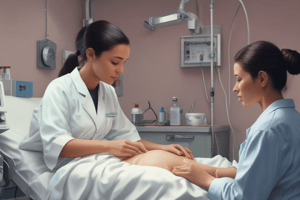Podcast
Questions and Answers
What is the maximum percentage of weight loss that is considered normal for a newborn after birth?
What is the maximum percentage of weight loss that is considered normal for a newborn after birth?
- 20%
- 15%
- 5%
- 10% (correct)
Which cause of postpartum hemorrhage is associated with uterine atony?
Which cause of postpartum hemorrhage is associated with uterine atony?
- Thrombin
- Tone (correct)
- Tissue
- Trauma
What is the primary method used to help maintain temperature control in newborns?
What is the primary method used to help maintain temperature control in newborns?
- Swaddling
- Kangaroo method
- Radiant warmer
- All of the above (correct)
Which of the following is used to test for hip dysplasia in newborns?
Which of the following is used to test for hip dysplasia in newborns?
Which emotional status changes might a postpartum woman experience?
Which emotional status changes might a postpartum woman experience?
What is a significant sign of inflammation in the context of episiotomy care?
What is a significant sign of inflammation in the context of episiotomy care?
What factor is most important to monitor in newborns for their health immediately after birth?
What factor is most important to monitor in newborns for their health immediately after birth?
What condition can occur in premature newborns when they are on oxygen?
What condition can occur in premature newborns when they are on oxygen?
What is the primary indication for performing amnioinfusion?
What is the primary indication for performing amnioinfusion?
Which condition may warrant the induction of labor?
Which condition may warrant the induction of labor?
A Bishop Score of 6 or higher suggests that a patient is a potential candidate for what?
A Bishop Score of 6 or higher suggests that a patient is a potential candidate for what?
What complication can be assessed with forceps during delivery?
What complication can be assessed with forceps during delivery?
Which statement describes the difference between caput succedaneum and cephalohematoma?
Which statement describes the difference between caput succedaneum and cephalohematoma?
What is a common position for a client to relieve compression from cord prolapse?
What is a common position for a client to relieve compression from cord prolapse?
Which of the following is NOT part of the 'BUBBLE' assessment postpartum?
Which of the following is NOT part of the 'BUBBLE' assessment postpartum?
In the context of postpartum complications, what does a midline and firm uterus indicate?
In the context of postpartum complications, what does a midline and firm uterus indicate?
Flashcards
Postpartum Bladder Emptying
Postpartum Bladder Emptying
The emptying of the bladder after childbirth, it is important to check if the woman's bladder is full and empty regularly. A full bladder can impede uterine contraction and increase the risk of postpartum hemorrhage.
Uterine Atony
Uterine Atony
A condition where the uterus does not contract after childbirth resulting in excessive bleeding. This can be caused by factors such as multiple pregnancies, diabetes, prolonged labor or a full bladder.
Dystocia - Difficult Labor
Dystocia - Difficult Labor
The process of giving birth is complicated and can sometimes be difficult, leading to prolonged or obstructed labor. This can be caused by factors such as obesity, large babies, or maternal exhaustion.
Baby Weight Loss
Baby Weight Loss
Signup and view all the flashcards
Ortolani Test
Ortolani Test
Signup and view all the flashcards
Necrotizing Enterocolitis (NEC)
Necrotizing Enterocolitis (NEC)
Signup and view all the flashcards
Retinopathy of Prematurity
Retinopathy of Prematurity
Signup and view all the flashcards
Newborn Temperature Control
Newborn Temperature Control
Signup and view all the flashcards
What is Amnioinfusion?
What is Amnioinfusion?
Signup and view all the flashcards
What is Induction?
What is Induction?
Signup and view all the flashcards
What is a Bishop Score?
What is a Bishop Score?
Signup and view all the flashcards
What are forceps used for, and what complication can occur?
What are forceps used for, and what complication can occur?
Signup and view all the flashcards
What is a Vacuum-assisted Delivery, and what potential complication should be assessed?
What is a Vacuum-assisted Delivery, and what potential complication should be assessed?
Signup and view all the flashcards
What is Cord Prolapse, and what is a critical symptom?
What is Cord Prolapse, and what is a critical symptom?
Signup and view all the flashcards
What is Bladder Distention, and why is it important to assess?
What is Bladder Distention, and why is it important to assess?
Signup and view all the flashcards
What are the normal characteristics of the uterus after childbirth?
What are the normal characteristics of the uterus after childbirth?
Signup and view all the flashcards
Study Notes
Amnioinfusion
- Procedure of putting fluid back into the uterus
- Baby may become hypotonic (unable to move freely)
- Indications include severe variable deceleration due to cord compression
- Also used for oligohydramnios (due to placental insufficiency)
Induction of Labor
- Medical or mechanical initiation of labor
- Cervix ripening (softening and dilation) may be required
- Indications include maternal exhaustion, gestational hypertension/diabetes, prolonged labor, and prolonged premature ROM
- Prolonged gestation or dystocia (difficult labor)
- Bishop Score of 6+ is favorable for VBAC (Vaginal Birth After Cesarean)
Score, Dilation, Effacement, Station, and Cervical Consistency
- Bishop Score is used to assess potential VBAC candidates
- Score is based on dilation (cm), effacement (%), cervical station, and cervical consistency
- Different score values correlate with specific cervical positions, ranging from posterior to anterior
Forceps and Vacuum-Assisted Deliveries
- Forceps: used to assist in delivery, assessed for potential facial palsy (petechiae).
- Vacuum extraction assessed for cephalohematoma (swelling that doesn't cross suture lines).
- Swelling generally appears 2-3 days after birth and resolves within weeks or months.
- Caput succedaneum: swelling that crosses suture lines, resolves in 3 days.
Cord Prolapse
- Partial or total cord occlusion with rapid fetal deterioration
- This is a common issue in breech babies.
- Cord can be hanging outside vagina or occult (hidden, at the back of the vagina)
- Client should be in hands and knees position to relive compression.
Postpartum Complications
- Breast assessment (contour, size, pain, temperature)
- Uterine assessment (fundal height, firmness, midline)
Bladder and Bowel Function
- Assess bladder (distention, voiding, dysuria [painful urination]), report burning, or incomplete emptying.
- Assess bowels (bowel movements).
Lochia
- Lochia is vaginal discharge postpartum
- Rubra (dark red): 1-4 days
- Serosa (pinkish brown): 5-9 days
- Alba (creamy white): >10 days
- Report any unusual odor or changes in color/amount.
Episiotomy/Perineum
- Proper wound healing is crucial
- Report any pain, inflammation (swelling, redness, discharge), or calf pain with dorsiflexion of foot.
Emotional Status
- Assess for depression or mood swings
Causes of Postpartum Hemorrhage (Four T's)
- Tone (uterine atony), Tissue (retained placenta/clots/subinvolution), Trauma (lacerations/hematoma/inversion/rupture), and Thrombin (coagulopathy)
Uterine Atony
- Multiple gestations, gestational diabetes/hypertension, polyhydramnios, and/or prolonged labor are associated causes
- Assess for adequate uterine contractions postpartum
Dystocia
- Obesity, macrosomia, maternal exhaustion, ineffective pushing, and age is often factors contributing to problems in childbirth
Baby Weight Loss
- Normal for newborn to lose weight after birth, weight loss should not exceed 10%
Ortolani Test
- A test for determining hip dysplasia
- Assessing for proper range of motion and sound during hip abduction (spreading the legs apart) and adduction (bringing the legs together)
Necrotizing Enterocolitis (NEC)
- Inflammation of the stomach and colon
- Breastmilk may help fight against NEC.
Retinopathy of Prematurity (ROP)
- Excess oxygen exposure in premature newborns can cause retinopathy.
Temperature Control
- Maintain newborn temperature above 97.7°F.
- Skin-to-skin contact (kangaroo method) and radiant warmer are crucial.
Postterm Babies
- Thin umbilical cord
- Dry,cracked skin
- Macrosomia
- Long fingernails
Transient Tachypnea of the Newborn (TTN)
- Mild respiratory distress
- Results from delayed clearance of fetal lung fluid, often associated with Cesarean births
Tracheoesophageal Fistula (TEF)
- Congenital condition where trachea and esophagus are connected
- Choking may occur during the initial feedings.
Newborn Sleeping
- Alone on the back, in a crib
- Alone and supervised
Umbilical Cord Care
- Clean umbilical cord with antibacterial soap and water.
PKU
- Part of newborn screening
- Heel stick test.
Respirations in Newborns
- Irregular/shallow breating, abdominal breathing, short periods of "non-breathing".
Skin Variations in Newborns
- Vernix (thick, white wax substance), often seen in folds.
Reflexes in Newborns
- Rooting, tonic neck, Moro, grasping, babinski, gag, and blink reflexes.
Transient Emotions
- Passive immunity: Antibodies from mother to newborn (breastmilk and immunoglobulins)
- Active immunity: Individual's own immune system (through disease or vaccines)
- Natural immunity: Physical barriers like skin and mucous membranes protect the body.
Chemical Barriers
- Gastric acids and digestive enzymes.
- Acquired immunity: Development of antibodies and lymphocytes.
Subinvolution
- Incomplete uterus shrinking; treated with antibiotics.
Cesarean Section (C-Section)
- Types include low transverse (most suitable for VBAC) and classical (more risky for VBAC).
Studying That Suits You
Use AI to generate personalized quizzes and flashcards to suit your learning preferences.




